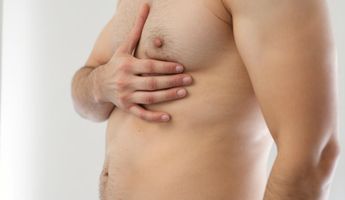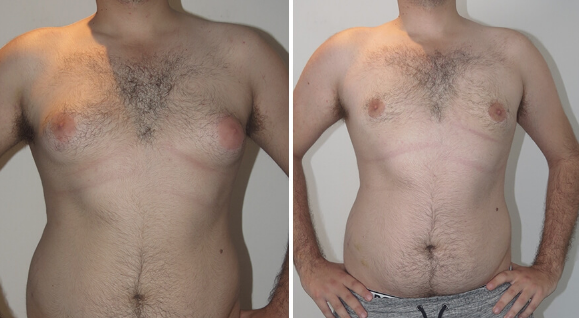Male Breast Reduction in Saudi Arabia
Search and Compare the Best Clinics and Doctors at the Lowest Prices for Male Breast Reduction in Saudi Arabia

Find the best clinics for Male Breast Reduction in Saudi Arabia
No clinics available
India offers the best prices Worldwide
Price: $ 692

- Home
- Saudi Arabia
WHY US?
At Medijump, we're making medical easy. You can search, compare, discuss, and book your medical all in one place. We open the door to the best medical providers worldwide, saving you time and energy along the way, and it's all for FREE, no hidden fees, and no price markups guaranteed. So what are you waiting for?

Free

Best Price

Widest Selection

Risk-Free
What you need to know about Male Breast Reduction in Saudi Arabia

Male breast reduction, also known as gynecomastia correction, is a surgical procedure to treat overdeveloped male breasts or gynecomastia – a condition in which male breasts are enlarged due to imbalance of the hormones estrogen and testosterone. The procedure is usually performed on men whose physical health is affected by the condition or men who feel uncomfortable or self-conscious about their chest. The ideal candidates for this procedure are healthy men with skin that is elastic to adjust to breast reduction.
What Does the Procedure Involve?
Male breast reduction is carried out under general anesthetic or local anesthetic with sedation. The procedure starts by making an incision around the nipple to remove fat as well as glandular tissue from the breast, as well as some excess skin. In some cases, your surgeon may also perform liposuction in conjunction with the procedure to remove fat. The final step of the procedure is closing the incisions with stitches.
How Long Should I Stay in Saudi Arabia for a Male Breast Reduction Procedure?
The procedure is usually performed on an outpatient basis, meaning you can leave the hospital on the same day of the surgery. However, you should not leave Saudi Arabia immediately to allow your body to recover and attend follow-up hospital checkups. Plan to stay in the country for at least 5 to 10 more days.
What's the Recovery Time for Male Breast Reduction Procedures in Saudi Arabia?
The total recovery period until you can go back to your full routine can take around a month. However, some people whose jobs are not physically demanding are able to return to work as well as some of their activities in 1-2 weeks.
What sort of Aftercare is Required for Male Breast Reduction Procedures in Saudi Arabia?
Your surgeon will give you detailed instructions on how to care for your surgical wounds as well as diet and exercise to avoid complications. You may need to wear a pressure garment during your recovery period to reduce bruising and swelling. To maintain the result of your surgery, make sure to maintain a healthy weight by making some healthy lifestyle changes.
What's the Success Rate of Male Breast Reduction Procedures in Saudi Arabia?
The procedure is generally safe and highly successful. However, just like other types of surgery, it carries some degree of side effects and risks that you need to be aware of. The side effects and risks include skin injury, noticeable scar, permanent pigment changes in the breast, slightly mismatched nipples or breasts, loss of breast sensation, numbness, and excessive bleeding.
Are there Alternatives to Male Breast Reduction Procedures in Saudi Arabia?
Male breast reduction is currently the most effective treatment to reduce enlarged male breasts. If you do not want to undergo surgery, you need to consult with your doctor about what your best options are. In some cases, your doctor may recommend liposuction to remove excess fat from your breasts, but leaving breast gland tissue intact.
What Should You Expect Before and After the Procedure
Before male breast reduction, your enlarged breast may affect you physically or you may feel very self-conscious. After the procedure, your self-esteem and self-confidence may increase significantly and any physical problems you experience before the procedure should be gone.
Whilst the information presented here has been accurately sourced and verified by a medical professional for its accuracy, it is still advised to consult with your doctor before pursuing a medical treatment at one of the listed medical providers
No Time?
Tell us what you're looking for and we'll reachout to the top clinics all at once
Enquire Now

Popular Procedures in Saudi Arabia
Price on Request

Prices Start From $2

Prices Start From $556

Prices Start From $2,473

Recommended Medical Centers in Saudi Arabia for procedures similar to Male Breast Reduction

- Interpreter services
- Translation service
- Religious facilities
- Medical records transfer
- Medical travel insurance
- Health insurance coordination
- TV in the room
- Safe in the room
- Phone in the room
- Private rooms for patients available

- Interpreter services
- Translation service
- Religious facilities
- Medical records transfer
- Medical travel insurance
- Health insurance coordination
- TV in the room
- Safe in the room
- Phone in the room
- Private rooms for patients available

- Interpreter services
- Translation service
- Religious facilities
- Medical records transfer
- Medical travel insurance
- Health insurance coordination
- TV in the room
- Safe in the room
- Phone in the room
- Private rooms for patients available

- Interpreter services
- Translation service
- Religious facilities
- Medical records transfer
- Medical travel insurance
- Health insurance coordination
- TV in the room
- Safe in the room
- Phone in the room
- Private rooms for patients available
Male Breast Reduction in and around Saudi Arabia
Introduction
The Kingdom of Saudi Arabia is the birthplace of Islam and is home to the holy Muslim city of Mecca, all Muslims are required to make a pilgrimage to this city at least once during their life and non-Muslims are forbidden from the city. There are other wonders to be found here, from the Red Sand Dunes in Riyadh, Jeddah’s coral architecture, to the azure waters of the Red Sea. In the last few years, the Kingdom has developed a plan to encourage international patients to seek treatment at its medical centers. The healthcare sector in the country has constantly improved and developed and the country has all the attributes to have a successful medical tourism industry, such as ultra-modern hospitals that are well-equipped with cutting-edge technology, foreign-trained doctors and specialists, and a well-established private healthcare sector.
Popular Cities and Regions in Saudi Arabia
The capital city is Riyadh, which is one of the wealthiest cities in the world. It offers amazing attractions for tourists, such as the Masmak Fortress, the National Museum, the Kingdom Center, the Sky Bridge, Riyadh Zoo, and the Antiquities Museum. Another popular city is Jeddah, which is called the Bride of the Red Sea. It’s a large metropolitan city with an incredible waterfront and beautiful old town. It’s the traditional gateway to Mecca, as well as the historic crossroads of traders and pilgrims. Most tourists visit this city to admire its World Heritage Red Sea architecture, explore its lively souq, relax in its laid-back coastline, and try its world-class cuisine.
Transport in Saudi Arabia
King Fahd International Airport is the largest airport in Saudi Arabia, located in the city of Dammam. It serves flights to and from numerous cities in Europe, Asia, and the Middle East. Domestic flights are the best way to travel around this country. Buses, taxis, and car rental are widely available for travel inside the cities.
Visas in Saudi Arabia
Almost all nationalities need to have a visa to visit Saudi Arabia, except for citizens of Bahrain, Kuwait, Oman, and the UAE. eVisa or visa on arrival is available for holders of passports of 51 countries, including all EU countries, the US, the UK, and Japan. Most other countries need to obtain a visa prior to arrival.
Weather in Saudi Arabia
Saudi Arabia has two seasons, summer and winter. Summer (April – October). The weather is extremely hot and humid. The average temperatures range between 40oC to 45oC, but it can soar to 49oC. Winter, from November to March, brings mild temperatures, with an average of 20oC during the day and 10oC during the night.
Additional Info
- Local Currency: Saudi riyal (SAR) is the currency. 1 USD is equivalent to 3.75 SAR.
- Money & Payments: ATMs are widespread and credit cards are widely accepted. There is no tipping culture.
- Local Language: Arabic is the official language, but English is widely spoken.
- Local Culture and Religion: Women do not need to wear abayas (a long black, robe-like dress) anymore, except at religious sites. However, both men and women have to wear modest clothing and refrain from showing too much skin. Islam is the state religion and the country’s law requires all citizens to be Muslim. Any non-Muslims who want to acquire Saudi Arabian nationality will have to convert to Islam. There are Hindus, Christians, and Buddhists in the country but all of them are foreign nationals.
- Public Holidays: The most celebrated public holidays in Saudi Arabia are Eid Al-Fitr, Eid Al-Adha, ad National Day.
Popular Searches
- Plastic Surgery in Thailand
- Dental Implants in Thailand
- Hair Transplant in Thailand
- Breast Augmentation Thailand
- Gastric Sleeve in Thailand
- Gender Reassignment Surgery in Thailand
- Laser Hair Removal in Bangkok
- Botox in Bangkok
- Dermatology in Bangkok
- Breast Augmentation in Bangkok
- Coolsculpting in Bangkok
- Veneers in Turkey
- Hair Transplant in Turkey
- Rhinoplasty in Turkey
- Stem Cell Therapy in Mexico
- Rhinoplasty in Mexico
- Liposuction in Mexico
- Coolsculpting in Tijuana
- Rhinoplasty in Korea
- Scar Removal in Korea
- Gastric Sleeve in Turkey
- Bone Marrow Transplant in India
- Invisalign in Malaysia
- Plastic Surgery in the Dominican Republic
- Tummy Tuck in the Dominican Republic
- Plastic and Cosmetic Surgery in Poland
- Rhinoplasty in Poland
- Hair Implant in Poland
- Dental Implants in Poland
- IVF in Turkey